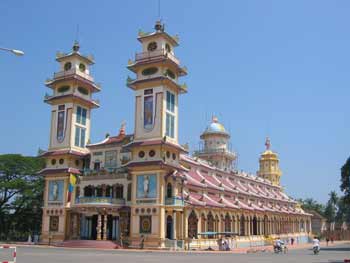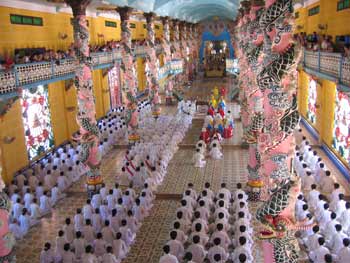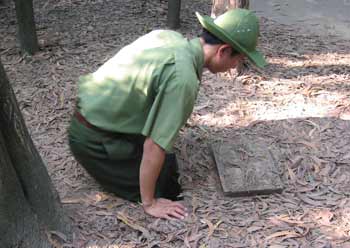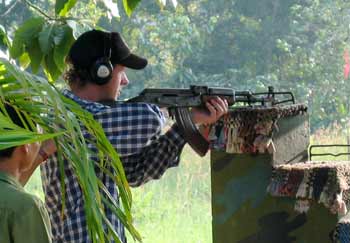The Tunnels of Cu Chi
27th October, Tay Ninh & Cu Chi, Vietnam
It was an early start for us this morning as we had a trip to Cao Dai Temple and the Cu Chi Tunnels planned. The itinerary promised an action-packed day and they were not lying!
Cao Dai Holy See Temple
The Cao Dai Great Temple (Thanh That Cao Dai) at Long Hoa in Tay Ninh is a temple with a difference. The architecture seems to have been influenced by several styles - Chinese, Islamic and European. This fusion seems to work in an odd kind of way. From a distance, the shape of the entire temple resembles a European church but a closer look at the detail soon dispels this impression. For on the structure, there are mosque-like domes, two Chinese-style towers, all covered in contrasting pastel colours with various pieces of artwork on them.
Caodai Temple at Tay Ninh.
The fusion of the many designs on the exterior gives a lot away in terms of understanding about the religion practised at this temple. Caodaism is a fairly new religion that was officially founded in 1926. Taking its influences from various religions and philosophies (like Christianity, Islam and Vietnamese spiritualism), much of the religion's doctrine is drawn upon Buddhism, Taoism and Confucianism.
The interior is very colourful and again, the theme of East and West was prevalent here too. There were statues of a Chinese general, Vietnamese poet and a French author, in amongst many others. Under the dome at the far end, is a large blue star-speckled globe with a big divine eye on it.
We had just arrived in time for the noon prayer session. All tourists were ushered to the upper balcony where we were allowed to watch and take pictures from above. We watched as the rows of women worshippers, all dressed in white robes, made their way into the temple from the left hand side. Then, the male worshippers, also dressed in white robes, filtered in from the right. After that, a small group of male worshippers, dressed in colourful robes, made their way in through the central section. They seemed of a higher rank as they moved further up towards the top, nearer to the globe with the divine eye. Once everyone had found their places, the prayer session commenced, with some live instrumental music and singing in the background.
Prayer time at Caodai Temple.
Cu Chi Tunnels
Cu Chi Tunnel was our next stop; there are two underground tunnels open to visitors and the one we visited today was at Bin Dinh. During the war, 250km worth of underground network was excavated out of red earth by the Viet Cong (VC) soldiers - going as deep as three storeys in places. This complex system of tunnels was used by armies of VC to move around incognito. These tunnels were sophisticated and had facilities dedicated to hospitals, kitchens, command centres, armoury and living quarters, all linked by narrow passageways.
The American GIs would have had difficulty penetrating these tunnels - it even
looks a squeeze for this Vietnamnese man.
A lot of thought had gone into constructing this underground hideout. The kitchen chimney's vents were located metres away from the complex and often surrounded by booby traps. Some entrances were found by the US troops who used sniffer dogs. Later the VC sprinkled pepper around the grounds to distract the dogs. They also started washing with US soaps and eating US-style foods so the dogs would confuse it for friendly smells. Trapdoors would be set up to stop tear gas, smoke and water from entering the main tunnel network; some sections even had electricity.
During the war, the tunnels were difficult to find as the exits were camouflaged by branches and leaves and often booby-trapped. There were even exits out to the river so the troops would not be trapped if the tunnel system collapsed. The VC would infiltrate close to the American troops, displacing many of their unsuspecting rivals before disappearing into these holes without a trace. What the peasant army lacked in armoury, they made up for in tactics.
Our guide took us through the jungle and showed us booby traps - rafts that when stepped on would flip and propel a human into a spear filled pit. We were also given an opportunity to walk through a 30m tunnel. It was very cramped and definitely made for petite Vietnamese soldiers. It was tough work walking through these narrow tunnels for ten minutes and I could only imagine how they lived underground for such long periods of time.
The group was given the opportunity to test out some of the machine guns. At $5 US (for 5 bullets), Ian did not hesitate to take up the chance of firing an AK-47 at the target posts. It was very loud and the ear shields were apparently not great. I stood, like many of the others in the audience, watching with fingers stuck in my ears to shield the noise.
Do you feel lucky punk? As in the man standing behind Ian!
After walking through the jungle in the heat, our journey home in an air con bus was greatly appreciated. As we arrived in Ho Chi Minh city, we had hit rush hour traffic. Bikes were everywhere and I'm glad we were inside the cool bus instead of the hot, motorbike-infested streets outside.



